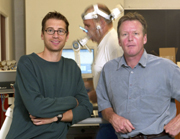 |
 |
|
|
 Axel Hulsemeyer (left) is
a new hire in Political Science. Among staff who joined the Arts and Science
barbecue held at Loyola during a day of orientation were Andrea Rodney,
Shelley Sitahal and Jean-Patrick Dorais (front), from the Office of Research
Services. Their director, Benoit Morin, explained the administrative support
for research to new faculty members at four orientation sessions held
August 26-29.
Photo by Andrew Dobrowolskyj
Axel Hulsemeyer (left) is
a new hire in Political Science. Among staff who joined the Arts and Science
barbecue held at Loyola during a day of orientation were Andrea Rodney,
Shelley Sitahal and Jean-Patrick Dorais (front), from the Office of Research
Services. Their director, Benoit Morin, explained the administrative support
for research to new faculty members at four orientation sessions held
August 26-29.
Photo by Andrew Dobrowolskyj
|
by Julie Parkins
Professor Robert Boushel believes in the theory that human beings were born
to exercise, and he and his colleague Gerald Zavorsky are setting out to
prove it with a major grant from the Canada Foundation for Innovation.
“I think we have an opportunity to provide a mechanistic basis for
why exercise is healthy and show how we adapt to physical activity,”
said Boushel. “Emerging science now shows that a lot of chronic degenerative
diseases are linked to inflammatory immune responses. It’s almost the
body’s way of saying that if you are inactive and overweight and not
eating right, your immune system is likely to respond by attacking you.
There is a healthy expression of genes in those who do regular physical
activity.”
The CFI grant awarded to the two professors in the Department of Exercise
Science is for $379,335, matched by the Quebec government for a total value
of $948,861.
The grant will be used to purchase equipment for the new Science Complex
to be opened at Loyola next year, and will be used to help the two researchers
study the regulation of blood flow and oxygen transport during exercise,
and vascular remodeling with training.
Boushel and Zavorsky will look at the regulation of blood flow and oxygen
transport from different angles. Boushel’s work will focus more on
diseased populations; in particular, vascular adaptations in diabetics,
and individuals withheart disease. “We have a major study with scientists
from four countries, and it’s a broad mechanistic study of vascular
and metabolic responses in diabetes,” he said. “We will be looking
at how blood vessels grow [and] how the inflammatory process in diabetics
affects their circulation.”
Zavorsky, a former All-Canadian in track and field, will look at these systems
from more of a global systemic view of the body.
“I work more from an athletic perspective,” he said. “It’s
really interesting to look at an elite athletic model, because they are
the people who are able to stress their lungs more than any other type of
person.”
“If we use these pieces of equipment to study not only the diseased
population but the athletic population, then we can gain a broader understanding
of how the cardiovascular system is regulated, and hopefully optimize training
programs or better medications or treatments for these people.”
Grant enables purchase of specialized equipment
One of the major pieces of equipment that will be purchased with the grant
is a Doppler ultrasound that will allow researchers to look at blood flow
all over the body. It will also allow them to quantify blood flow during
every heartbeat in both active muscle and inactive muscle.
“[The Doppler] will help us to an understanding of how blood flow from
the large arteries is distributed to the level of micro circulation,”
Zavorsky said.
Boushel added, “This grant was absolutely vital because we don’t
have labs here. This will allow us to be unique in Canada in terms of looking
at systemic circulation and how that’s regulated from the level of
the heart down to the capillaries. I think the equipment we got will set
us up to do some quite unique work in Canada.”
Perhaps most importantly, the equipment purchased with this grant will enable
more researchers at Concordia to be trained at using this equipment, which
could have far-reaching effects later down the road.
“The CFI invests in us so that we can train other students, so they
can become researchers in the future,” Zavorsky said.
|
|
|



